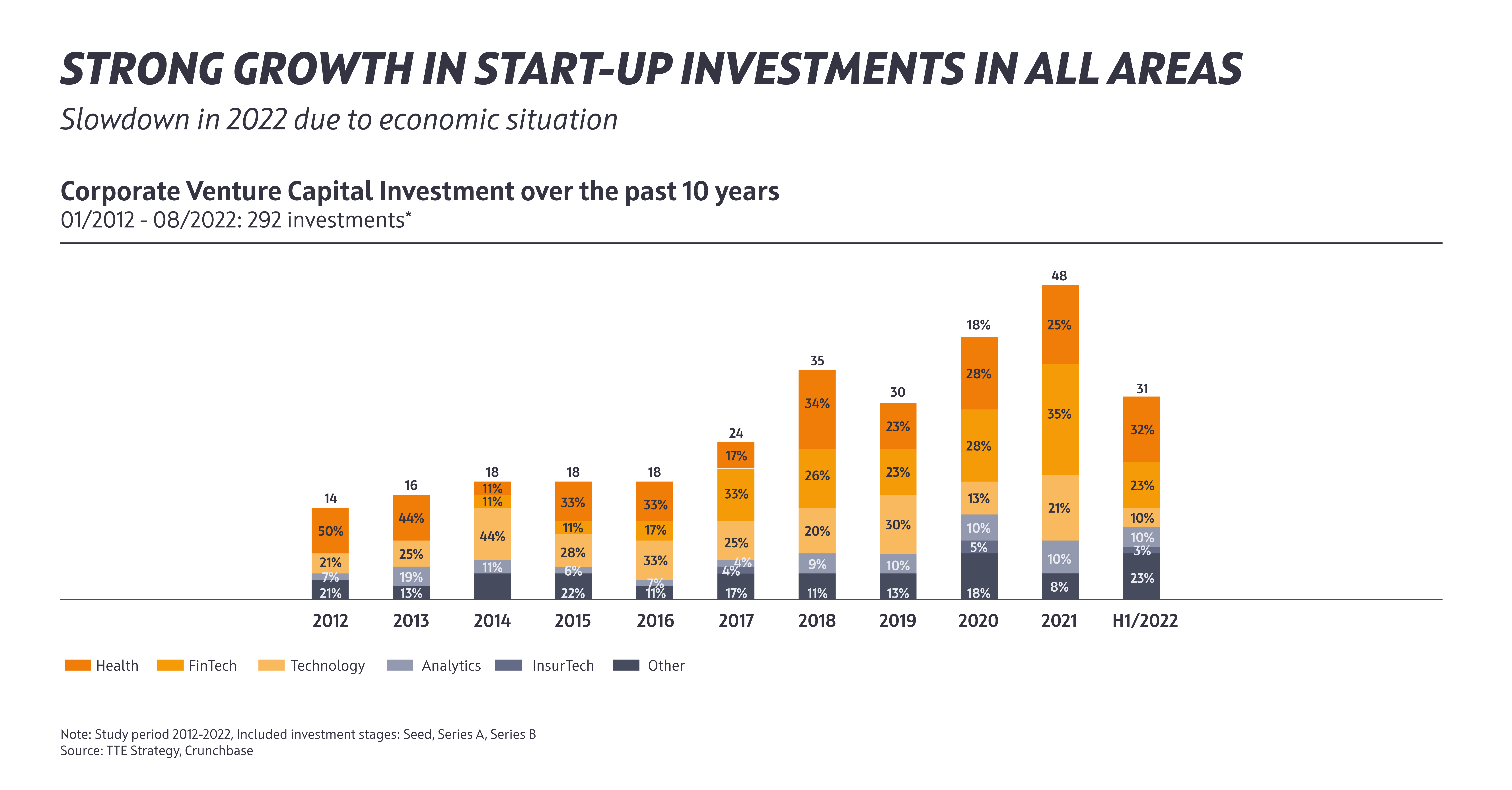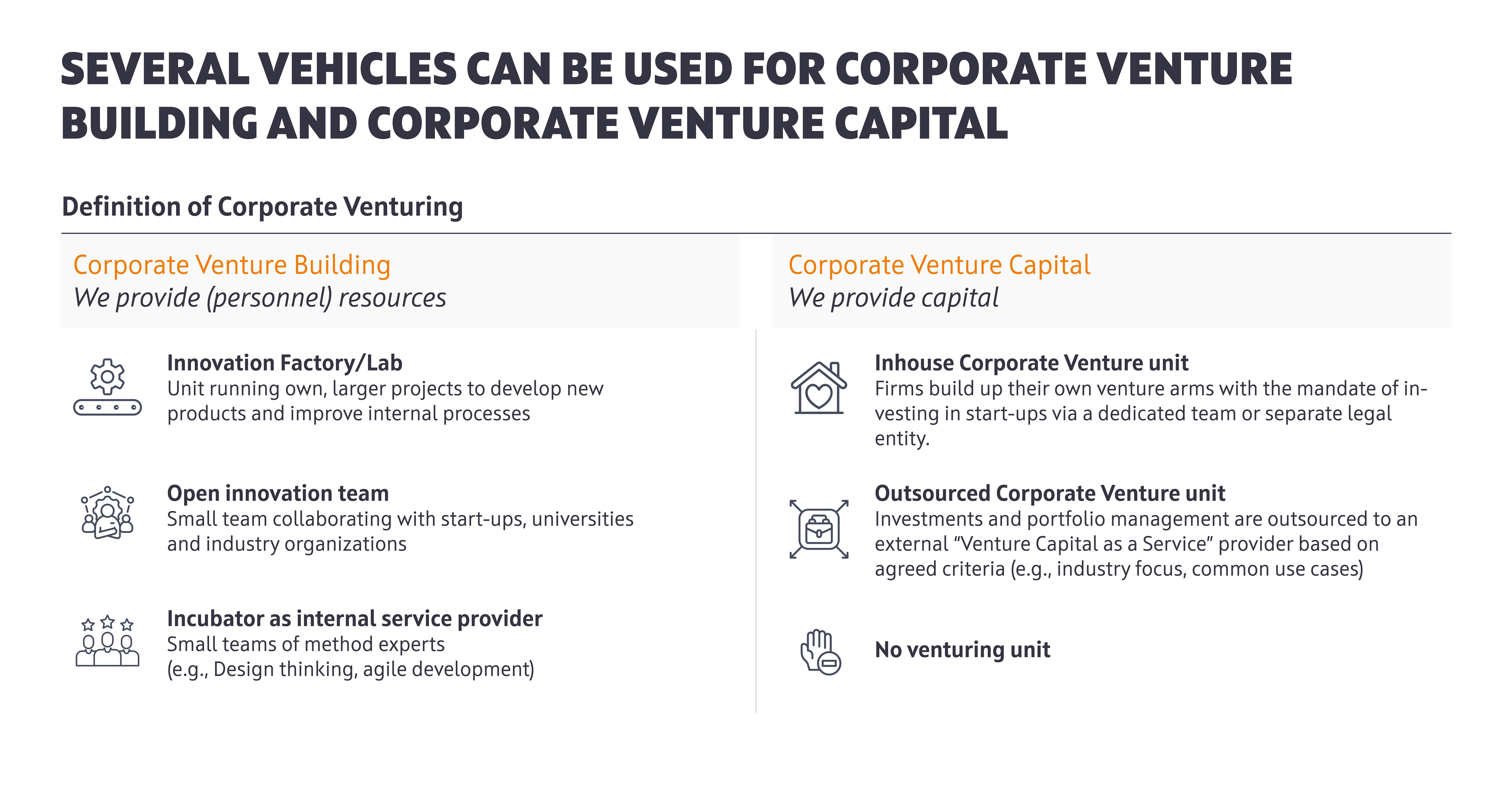
Banks and insurance companies in Switzerland have recently relied heavily on corporate venturing as an instrument for developing innovations in the financial services sector: that is, direct investments in start-ups or the establishment of their own innovation units. Satisfaction is mixed: successes can be found in all areas, but expectations have not yet been fully met, particularly in terms of new products, efficiency improvements, and growth. The industry will be refocusing its corporate venturing activities in the coming years.
The study looks in detail at 20 banks and 15 insurers respectively: 13 banks are active in corporate venturing, and in eight cases they have set up their own innovation units. Ten insurers have shown activities; six times they have founded innovation teams themselves. Twenty out of 35 financial service providers have provided capital for external ventures such as start-ups. In 11 cases, companies have both established internal units and provided external funding.
Specifically, all universal banks, two-thirds (67 percent) of cantonal banks, and well over half of private banks (57 percent) have recently relied on corporate venturing. The Swiss insurance companies show a similar picture: 78 percent of the life/non-life insurers use corporate venturing, as do half (50 percent) each of the reinsurers and the companies specializing in life and non-life insurance.

To promote innovation externally, Swiss financial service providers have provided venture capital to 292 start-ups since 2012. Topical focus: Health, FinTech, Technology, Analytics, and InsurTech.

Corporate venturing is used in many ways by Swiss financial services providers
Corporate venturing consists of two aspects: corporate venture building and corporate venture capital. In the area of corporate venture building, three forms of internal organizational unit have emerged: (1) Innovation factories/labs are internal units that work on new products and process improvements on the basis of current methods for promoting innovation. The goal: to bring these innovations in-house. (2) Open innovation teams are small teams that collaborate with external start-ups, leading scientists, and other third-party organizations to develop innovations together. (3) An incubator is a team made up of experts in agile methods such as design thinking and agile development who tinker with very specific innovation issues based on these methods.
For corporate venture capital, Swiss financial service providers have also relied on different methodologies. For example, they have established their own (1) in-house unit, which is focused on finding promising start-ups and making direct investments. Alternatively, the corporate venture capital activities were (2) outsourced to a “venture capital as a service” provider and thus the companies did not have to actively deal with the topic themselves. As a third observed option, (3) no dedicated unit was created at all, with corporate venture capital being integrated into daily business.
Learning culture established, but expectations of efficiency and earnings improvements not yet clearly met
To understand the impact of corporate venturing in more detail, TTE Strategy spoke directly with the companies studied. Companies have reported improved willingness and ability to learn and greater openness to innovation as outcomes of their activities. Similarly, corporate venturing has helped to increase employer attractiveness, especially for target groups with a high affinity for technology and digital. However, corporate venturing has also been an attractiveness booster for long-time employees, who have seen new prospects as a result.
When it comes to hard results, satisfaction was less pronounced. Expectations of increased efficiency, new products, and increased profits have not yet been met by many Swiss financial service providers. No one felt that the steps taken were wrong. But the potential output has been assessed differently in most cases. More had been expected here.
Patterns of success and failure are recognizable; companies are realigning their activities in 2023
Dissatisfaction with results often correlates with the same problems in the design of structure and processes for internal innovation units. In some cases, the objectives are too broad, in others too narrow, there are unrealistic estimates of possible results in relation to the capital and time invested, incorrect operating models, a lack of the necessary expertise, insufficient personal commitment on the part of those involved, and cultural incompatibility.
In principle, it is certainly better to “do” than “not do.” But in the course of doing, it is important to check again and again: Do we have a clear, achievable goal? Are we on the right track to get there? Are all relevant internal and external stakeholders pulling in the same direction? Are we creating real added value or are we threatening to overwhelm our own organization? It is the hallmark of agile entities to constantly realign themselves. Some of the Swiss companies have underestimated how fundamental these realignments can sometimes be in the context of driving innovation.
Most recently, companies have changed their focus in corporate venturing. In the coming years, it will now be a matter of reevaluating and realigning the internal, as well as external, investments made. It is those who have acknowledged their past mistakes that are best equipped to successfully launch the next round of corporate venturing in the Swiss financial industry.


TTE Strategy